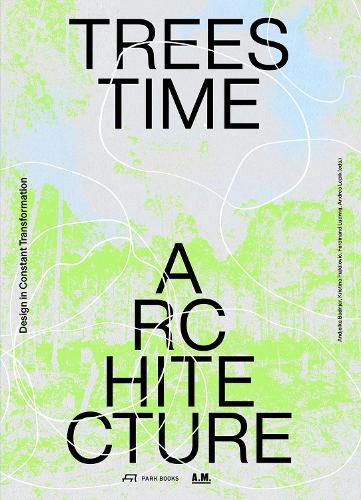Readings Newsletter
Become a Readings Member to make your shopping experience even easier.
Sign in or sign up for free!
You’re not far away from qualifying for FREE standard shipping within Australia
You’ve qualified for FREE standard shipping within Australia
The cart is loading…






Argues that the use of living trees in contemporary architecture can help cities adapt to climate change. Trees, Time, Architecture! introduces living plant construction as an important tool to improve the climate in our cities. In the form of a magazine, the volume brings together a variety of views on the relationship between trees and architecture, urban spaces, modernism, politics, feminism, and cultural values. This collage of historical, research-based and creative perspectives looks at how living trees can be preserved, used, and appreciated in the Anthropocene by taking into account their temporal dimension. It highlights ancient examples of living plant architecture, such as the root bridges of the Khasi people in India, Nordic mythology with its representation of a tree as a cosmological symbol, and the architectural use of living trees in the Roman Empire. The essays, photographs, memoirs, film reviews, and conversations in this book are supplemented with exemplary architectures, new research approaches, and current design methods. They illustrate dynamic processes in which trees play a key role as constantly changing organisms. They invite a transdisciplinary examination of relationships between people, trees, and architecture, as well as their rethinking and further development in our time of constant change and limited resources. AUTHORS: Andjelka Badnjar Gojnic is a research assistant at the Technical University of Munich's (TUM) Chair of Architectural History and Curatorial Practice and a curator at the Architekturmuseum der TUM. Kristina Pujkilovic is a research associate at the Professorship for Green Technologies in Landscape Architecture at the Technical University of Munich (TUM). Ferdinand Ludwig is Professor of Green Technologies in Landscape Architecture at the Technical University of Munich (TUM). Andres Lepik is the director of the Architekturmuseum der TUM and Professor of Architectural History and Curatorial practice at Technical University of Munich (TUM). SELLING POINTS: . Introduces living plant construction as an important tool to improve the climate in our cities . Brings together a variety of views on the relationships between trees and architecture, urban spaces, modernism, politics, feminism, and cultural values . Presents approaches to living plant construction from various world regions and ages through wide range of media, such as photographs, graphic essays, documentary reports, and film reviews . Accompanies the Trees, Time, Architecture! Design in Constant Transformation exhibition at the Architekturmuseum der TUM, Pinakothek der Moderne in Munich 13 March 13 to 14 September 2025 80 colour, 50 b/w illustrations
$9.00 standard shipping within Australia
FREE standard shipping within Australia for orders over $100.00
Express & International shipping calculated at checkout
Argues that the use of living trees in contemporary architecture can help cities adapt to climate change. Trees, Time, Architecture! introduces living plant construction as an important tool to improve the climate in our cities. In the form of a magazine, the volume brings together a variety of views on the relationship between trees and architecture, urban spaces, modernism, politics, feminism, and cultural values. This collage of historical, research-based and creative perspectives looks at how living trees can be preserved, used, and appreciated in the Anthropocene by taking into account their temporal dimension. It highlights ancient examples of living plant architecture, such as the root bridges of the Khasi people in India, Nordic mythology with its representation of a tree as a cosmological symbol, and the architectural use of living trees in the Roman Empire. The essays, photographs, memoirs, film reviews, and conversations in this book are supplemented with exemplary architectures, new research approaches, and current design methods. They illustrate dynamic processes in which trees play a key role as constantly changing organisms. They invite a transdisciplinary examination of relationships between people, trees, and architecture, as well as their rethinking and further development in our time of constant change and limited resources. AUTHORS: Andjelka Badnjar Gojnic is a research assistant at the Technical University of Munich's (TUM) Chair of Architectural History and Curatorial Practice and a curator at the Architekturmuseum der TUM. Kristina Pujkilovic is a research associate at the Professorship for Green Technologies in Landscape Architecture at the Technical University of Munich (TUM). Ferdinand Ludwig is Professor of Green Technologies in Landscape Architecture at the Technical University of Munich (TUM). Andres Lepik is the director of the Architekturmuseum der TUM and Professor of Architectural History and Curatorial practice at Technical University of Munich (TUM). SELLING POINTS: . Introduces living plant construction as an important tool to improve the climate in our cities . Brings together a variety of views on the relationships between trees and architecture, urban spaces, modernism, politics, feminism, and cultural values . Presents approaches to living plant construction from various world regions and ages through wide range of media, such as photographs, graphic essays, documentary reports, and film reviews . Accompanies the Trees, Time, Architecture! Design in Constant Transformation exhibition at the Architekturmuseum der TUM, Pinakothek der Moderne in Munich 13 March 13 to 14 September 2025 80 colour, 50 b/w illustrations